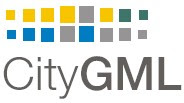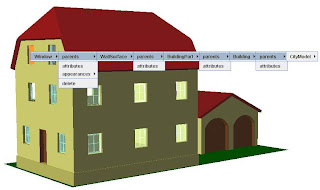These 3D models can only be used for visualization purposes but not, in most cases, for thematic queries, analytical tasks or spatial data mining. Another problem with these and other city 3D modeling efforts is lack of interoperability. Web-aligned open standard geometry models for computer graphics (e.g., X3D and geospatial technologies (Geography Markup Language 3 (GML3)) are available but still relatively new and not yet widely adopted. Though their common XML foundation provides the elements needed for convergence, this has not been addressed (not yet anyway). Moreover, in those cases where semantic and topological aspects are considered, there are no widely used standard application schemas, though such schemas are under development, drawing on a considerable body of previous data modeling work. Without a common definition of the basic entities, attributes and relations that can be shared over different applications, those who develop and own the models find it difficult to share and maintain them.


So, in short, some of City GML's features include:
- Geospatial information model for urban landscapes based on the ISO 191xx family
- GML3 representation of 3D Geometries, based on the ISO 19107 model
- Texture and material representation of object surfaces
- Taxonomies and aggregations
- Digital Terrain Models as a combination of (including nested) triangulated irregular networks (TINs), regular rasters, break and skeleton lines, mass points
- Sites (currently buildings; bridges and tunnels tbd. in the future)
- Vegetation (areas, volumes, and solitary objects with vegetation classification)
- Water bodies (volumes, surfaces)
- Transportation facilities (both graph structures and 3D surface data)
- City furniture
- Generic City objects and attributes
- User definable (recursive) grouping
- Multiscale model with 5 well-defined consecutive Levels of Detail (LOD):
a) LOD 0 : Regional, landscape
b) LOD 1 : City, region
c) LOD 2 : City districts, projects
d) LOD 3 : Architectural models (outside), landmarks
e) LOD 4 : Architectural models (interior)
- Multiple representations in different LODs simultaneously; generalization relations
- Optional topological connections between feature (sub)geometries
- Application Domain Extensions (ADE): specific "hooks" in the CityGML schema allow to define application specific extensions, for example for noise pollution simulation, or to augment CityGML by properties of the new National Building Information Model Standard (NBIMS) in the US
To provide (only some) names of bodies working on and supporting CityGML: municipalities of Berlin, Hamburg, Cologne, Düsseldorf, Recklinghausen, Leverkusen; British Ordnance Survey, State Mapping Agency of North-Rhine Westphalia; companies T-Mobile, Rheinmetall Defence Electronics, Snowflake, CPA Geo-Information, GIStec, 3D Geo; research institutions: Universities of Bonn, Potsdam, Dortmund, Applied Sciences Stuttgart; Research Centre Karlsruhe and Fraunhofer Institute for Graphics Research.


No comments:
Post a Comment